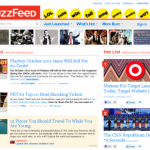Publishers Get Profitable With Programmatic & Waterfalling
Publishers of magazines and newspapers have been under pressure for quite some years now. There’s an old journalism saying that goes, “If it bleeds, it leads.” But terror attacks and plane crashes no longer seem to align exactly with most brands’ interests.
This story was originally published on igorbeuker.com
For those news organizations known as bastions of journalistic integrity, it’s getting harder to solve the inherent conflict between editorial and advertisers.
Even publishers who deal with more light-hearted content – celebrity gossip, for example – find themselves under pressure from the sales team to present brand-friendly content.
Being a pro public speaker and business journalist with an extended background in marketing and media, I am exceptionally fascinated in the trends and technologies that are shaking-up the broadcasting and publishing industries.
In this story I will talk about:
• Magazine and newspaper publishing, not books
• Trends, threats, and opportunities they need to tackle and coin
• Brilliant publishing examples from the USA, Sweden and South Korea
• The masters of digital publishing program & the ‘corporate garage’
• The importance of developing a smart overall ad exchange strategy
• How to grow ad revenues with programmatic and waterfalling
Trends, Threats and Opportunities In Publishing
One of the trends I see is that publishers are still struggling with the fact that journalism and storytelling have changed dramatically in the world of internet technologies.
Over the past decade I have learned that unless publishers know how to get their stories out in ways that are native to new digital platforms, will be left behind.
I am afraid that legacy publishers, and other ‘old skool’ media companies, whom are not innovating at the speed of change, will be dead men walking in a few years’ time.
But also the publishers that are eager to innovate and move quickly, find great difficulties in bridging the print vs. digital divide. They find it extremely tough to compete with companies like BuzzFeed and The Huffington Post.
These free spirit, digital natives have the luxury of focusing exclusively on digital content and advertising without suffering from legacy, linear thinking or cannibalization on existing business models.
Paid subscriptions and paywalls are topics that have been keeping many senior managers in publishing land awake at night. Certainly millennials need to be tortured to pay for “old news’ (print) and even news on digital platforms should be free in their eyes.
A player like Vice however, led by co-founder and CEO Shane Smith, could be described as mash-up of MTV and CNN. Vice is able to make news in ways that is appealing to the screenager generation.
But not all publishers went from profit to perish. Why did you think that Amazon founder and CEO Jeff Bezos paid $250 million for The Washington Post in 2013?
Or take a look at the digital success story of Sweden’s most-read newspaper Aftonbladet. They made more money from digital advertising than in print in 2012.
How about citizen journalism newspaper success OhmyNews from South Korea? This open source style reporting platform is a hit since mister Oh Yeon Ho launched it in the year 2000.
So despite all the roadblocks faced by publishers, I still see great opportunities for the publishers willing to jump into the future. First, though, they must overcome certain challenges.
One of these challenges is coining the trends and technologies of the 21st century. In particularly monetization and that will start with making smart strategic choices.
For example, finding the right ad exchange, real-time-bidding and programmatic advertising partners is a must have for publishers.
Increasing their digital advertising revenues is another priority topic in which programmatic waterfalling could help.
The Masters of Digital Publishing
But first, I might need to clarify, how I got to my insights, believes, opinions and solutions. That might give some context to my story and arguments. I guess.
Last 5 years I have been helping broadcasters and publishers across many markets to develop strategies on how to survive in the digital age of devastating innovation and the networked economy.
I dubbed the program for publishers Masters of Digital Publishing. In tailored programs, my output varies from an inspirational keynote speech, followed a full day masterclass with the board & management, to consultancy that ensures the program is integrated seamlessly across all divisions.
The content of the masterclass starts with looking outside-in: Showing publishers several meta trends that help them to understand the impacts new disruptive technologies will have on their existing business models: How can they capitalize on the huge opportunities of the 21st century?
As benchmark I show them the digital journeys of The New York Times and Wall Street Journal, and what their learnings and mistakes have been. This module includes of course how publishers can win new (digital) subscribers, the people that are willing to pay for premium content and services.
The module also reveals advanced mechanisms on intelligent prospecting and individual dynamic pricing, and how it can help publishers to pull more paid memberships through their funnels.
Innovation and the CIO are an important part of my program too. For example how a publisher can launch a corporate garage aka startup on request, and how this hybrid, disruptive greenfield can win new territories and markets.
Yes, indeed. Being able to innovate at the speed of change is incredibly important for legacy publishers. It’s crucial.
A very inspiring part of the program is how publishing houses can increase their revenues and ROI with social media, online video and mobile. Showing some wickedly clever examples triggers the imagination of the participants and lowers resistance. This part even makes some of the stubborn or grumpy editors-in-chief smile.
During the program I also challenge the status quo: What will you do when number of digital consumers using ad-blocking tools keeps rising? How will this impact your current business model and how are you going to anticipate similar trends?
Being prepared is key. That means having strategic scenarios in place before the transformation.
For the ones who need it, and in my experience the answer is going to be 90% of all publishers, I have developed and added a module to the program that is called:
Ad Exchange strategy.
I have learned that publishers really need all the help they can get in this area. Challenge is that some of them have already jumped on the wrong bandwagon and are now riding the highway to hell.
They do need a lot of reflections and a shock treatment, to really understand that they should stop at the next exit, disembark, and find a new strategic route to get onto the stairways to heaven.
Not always easy, but certainly a very intriguing process.
Why Publishers Must Have A Solid Ad Exchange Strategy?
During all the keynotes, masterclasses and interactions with so many publishers around the globe, I came to the following common denominators.
Most legacy publishers:
A. Struggle with the monetization of advertising across all their digital channels
B. Lack experience and skills when it comes to RTB and programmatic advertising
C. Are under so much pressure that they skip the so crucial ad exchange strategy
D. Are in a deadlock, suffering from choosing the wrong ad exchange partner
E. Have not investigated their waterfalling opportunities yet
Before I touch the benefits of waterfalling for publishers, I need to address the importance of having a clever overall ad exchange strategy. Having that is 10 times more important than any waterfalling attempt.
I must admit, it worried me to see that so many publishers have hooked up with the wrong ad exchange partners. Meaning their hit and run play, without having a strategy in place at all.
Legacy publishers, but even some digital pure players, tend to choose their ad exchange partner(s) based on poor insights and intel. Mostly because of their need for speed. Sometimes due to their lack of experience in this specific field.
But let’s be bold. Copying the ad exchange approach from the competition, without developing a rock-solid strategy? That would be the same as Felix Baumgartner jumping without a parachute!
Take for example digital pure players like comparison platforms. Some of their business models are completely build on Google Search. Nevertheless they have chosen the Google Exchange to be their exclusive partner.
To next come to the painful insights and conclusion that the exact same Google has become their worst enemy, since their entire comparison business model is being demolished bottom-up by Google Shopping. Can you imagine such a disastrous strategic failure?
Similar ignorant missteps shocked me at several other leading publishing houses. Where the CEO told me proudly “The Google Exchange Igor, just because it feels good, its great company, we recently visited them and the trip was awesome”.
But WTF? Are you just telling me that you’ve put your whole digital ad business model at risk because you had a nice trip to Mountain View?!
But now comes the problem. These publishers are locked-in hard, by a close friend that turns out to be the enemy aka the devil, neatly dressed up in Prada. Such a decision might cost the publisher millions.
Publishers should be betting on the right horse. Or should I say horses? Make sure they choose the right strategic ad exchange partners. Based on a solid business case an vision, not on assumptions.
In my experience there is one fundamental strategic choice that most publishers missed out on in their programmatic strategy: Big-data.
Remember, new marketing is about relationships, not the medium.
Sure, a quick win for publishers seems to be dumping their ad inventory onto several ad exchanges, in the hope to make a quick extra buck. But if monetizing ad impressions means losing all other strategic benefits of data-driven insights, Houston we have a problem!
Having actionable data and insights will enable the publisher to maximize its programmatic return on investment. Losing these long term benefits over some hit and run monetization of ads, is not a very smart strategy. Or simply not a strategy at all. I can’t even call the approach ‘tactics’.
Especially when publishers understand that RTB platforms are becoming much smarter, and due to their volumes will be in the know of what the value of an impression should is, or should be.
Why would any advertiser or media agency in the world buy an ad impression at publisher X with a floor of $1,50 CPM, if they can reach the same ‘customer persona’ for $0,75 CPM at the website of publisher Y?
Large leading publishers have very valuable consumer data which could really enrich the impressions and maximize the return on investment of their advertizers. But not if the publisher is solely focused on hit and run moneymaking, and has totally forgotten about the added value of enriched data.
So a data-driven programmatic approach, that is what large publishers should embed in their ad exchange strategies. Never run blindfolded into the arms of a new partner to next discover it’s a lousy marriage.
Next is there is a major mobile importance for publishers.
A fast growing part of the publishers’ impressions are now coming from mobile devices and tablets, and it’s safe to say that mobile impressions will easily beat the number of desktop generated impressions. This means that publishers will have to ramp up their mobile programmatic strategies too.
Sorry, but the nonchalant attitude towards mobile makes me rebellious sometimes.
Because mobile is most definately the next huge gateway to content, brands, friends and shopping.
Mobile will be even much bigger that the (desktop) Internet.
The next step for publishers is to make sure that they are identifying which devices their returning visitors are using when they visit their sites. By doing so publishers can again enrich the impressions with ‘exclusive’ data to increase the value and ROI.
They should be able to recognize and act upon these actionable insights like for example: “Hey, Igor is back, but this time he is visiting our new website from his tablet. Or iPhone.”
The programmatic ad serving strategy, especially the ones for publishers, must have big-data and mobile embedded. Publishers that don’t embrace this data-driven approach, will soon start to lose advertisers.
Because leading brands data-driven and want data-driven-insights and establish relationships with consumers. That’s way more important to them than that little density (aka discount) that publishers are offering them in their floor prices.
Going for the lowest floors and CPMs that are not enriched by data, that could be the tactics from your media agency. Because they still think that new marketing is about the medium, not relationships.
Most important tip I have for publishers when it comes to developing their ad exchange strategies? Google and Facebook are media companies, masqueraded as technology companies. Need I say more?
Going towards the programmatic waterfalling opportunities, I need to make a few more remarks on the overall ad exchange strategy for publishers.
Although many publishers could load balance their inventory much smarter when it comes to floors and second auctions, they should stay aware that large buying firms like i.e. GroupM try to negotiate pricing by means of launching private auctions.
It would be ignorant from publishers to jump into such a setting blindly. There might be better ways to leverage a publisher’s inventory, without demolishing their business model at the foundation.
Before jumping in with i.e. but not specifically the Google’s and GroupM’s of this world, publishers will first need to consider their other options. And there are many.
From private exchanges to for example considering to offer a discount at the end of their funnel. Because no programmatic bible on this planet ever told publishers that the discount always has to be at the beginning!
Or how about giving access to a dedicated set of impressions that is enriched with data like i.e.: In-view, socio-demographics, areas of interest, searched for, other online behaviors, intent of first look, etc.
Indeed, being limited to one exchange will have certainly limit the publishers possibilities to waterfall, however I would like to stress that this should all be tackled at the development of the publisher’s overall ad exchange strategy. Not one year after having implemented the chosen ad exchange partner.
So strategy is absolutely key. It takes an architect to envision and build cathedrals, everything else is just bricks in a wall.
How Waterfalling Can Increase Publisher’s ROI on Ads
But first, WTF is waterfalling? Publishers’ practice of waterfalling is best described as moving their ad inventory through various ad exchanges with the purpose of maximizing their yield.
However, it’s not always easy to demystify the secrets of programmatic waterfalls, since the topic is rather new to some publishers. How to keep such ‘tech-stack-talk’ stupid and simple?
Warning: I am not going to solve all publishing challenges in one story, since surviving in the digital age of devastating innovation goes way beyond moving inventories around across ad exchanges.
Trust me, I am very aware of that. However, all media companies must become tech companies nowadays.
Waterfalling is also not the holy grail in programmatic advertising, because waterfalling has also generated scrutiny and some befuddlement.
Why would waterfalling be necessary, if we assume auction systems are fair? Are real-time bidding platforms indeed going to be the super-efficient programmatic methods that will rule digital ads?
The key, according to a post at Datacratic, lies in three dynamics:
1. The way a second-price auction works
2. The nature of seller-set price floors
3. The fact that in real-time bidding systems ad impressions often only receive a single bid.
Remember, in a second-price auction, the winning bidder doesn’t pay his/her bidding price, but the price of the second-highest bidder.
But what if an auction for an ad impression only has one bid, which is not uncommon? Then, the winning bid typically pays the floor price, the supposed rock-bottom minimum that a publisher is willing to accept.
By cycling their inventory through various exchanges, publishers can ratchet down their floor price and feel reassured they are leaving less money on the table, keeping their floor as close as possible to the winning bid, while gradually also pulling in winning bids for each impression.
“They effectively reduce the difference between bid and price paid, thereby capturing additional revenue,” wrote Ari Paparo, CEO of RTB platform Beeswax, on Adexchanger.
As long as there’s a payoff to the practice, it’s likely sellers will continue to do it, even if it is relatively laborious and distorts (in critics’ view) auction incentives.
Another smart tactic beyond waterfalling across ad exchanges, could be time-related bidding in one ad exchange. This last tip might seem a bit techy at first, but it is in fact a commercial play.
To increase ROI, it could also be beneficiary to look at what buyers are doing in the exchange. I have seen some smart buying tactics that made me smile. Inventive ways I must say.
Buying impressions at the last part of an hourly-block might give nice impressions at a lower price. Why? Because yield-systems often try to get maximum results in blocks of one hour.
Meaning: At the end of each hour the demand might drop (a little) but the supply won’t.
And to be honest, does it really matter if a certain ‘customer persona’ is being reached within the first impression? Or could the second or the third impression for that same person be sufficient too?
I guess that the non-linear minds among you, are able to see more than one option.
My Opinion
Too many publishers out there have been acting like record labels. They knew that new disruptive business models were coming, but they are too worried about their short term ROI. They should have jumped 5 years ago. Many are now boiling frogs, a few dead men walking.
Sometimes I find it difficult to understand the human resistance and ignorance in the publishing industry. There’s no more space for ignorant DNAs and siloes. The approach must be integrated today. Today it’s integrate or die.
Why would corporate publishers want their editorial teams to have such strong voting rights? Editorials teams often can veto and even vote out their own editor-in-chief when he is willing to innovate, and to collaborate with the CIO, CMO and Sales units! Today it’s innovate or die.
Darwin was already crystal clear about it in his book On the Origin of Species in 1859. He wrote about the survival of the fittest and natural selection mechanisms. Translated to modern times: Are you innovating at the speed of change? Because today it is adapt or die even more than ever before.
Other old skool publishers have found wickedly new ways to create smart paid subscription models, some even based on intelligent prospecting and individual dynamic pricing.
To the the publishers that are moving towards data-driven digital integrated marketing, I would like to say: Keep doing so! You have seen the examples of new digital publishers that are growing faster than ever before.
Waterfalling could help publishers to maximize their ROI on digital advertising, but be very aware that having a smart overall ad exchange strategy is way more crucial.
Publishers that know how to get their stories out in ways that are native to new digital and mobile platforms, will be the future winners.
Happen to be inspired by the Masters of Digital Publishing program? Energized by the possibilities of the Startup on Request approach? Share your challenge.
What About You?
What keeps you awake at night when it comes to digital publishing? I’d love to hear your feedback and ideas.
Take Viralblog.com everywhere you go
Have an iPhone, iPhone Touch or iPad? Download the ViralBlog.com app for iOS
Samsung or other Android mobile phone/tablet? Download the ViralBlog.com app for Android
Follow ViralBlog on Twitter, LinkedIn, Facebook, Google+, Feedly.
Join us on Twitter, LinkedIn, Facebook, Google+, RSS
About the Author
Igor Beuker is pro speaker, author & awakener. Valued as one of the leading independent and outspoken voices on emerging #marketing #media #tech & #trends. Book Igor as keynote speaker or invite him to be part of your show.
Related Stories
Follow Category?Trends & Innovations |
Follow Author?Igor Beuker |
37 more
Follow Tags?. programmatic waterfallingad echange strategy for pubslihersaftonbladetbroadcasters |














